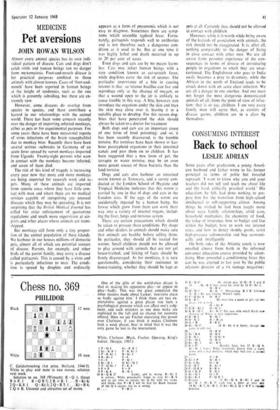Pet aversions
MEDICINE
JOHN ROWAN WILSON• Almost every animal species has its own indi- vidual pattern of disease. Cats and dogs don't catch colds and human beings run no danger from myxomatosis. Foot-arid-mouth disease is for practical purposes confined to those animals with cloven hooves. Cases of 'foot-and- mouth' have been reported in human beings at the height of-epidemics, such as the one which is presently subsiding, but these are ex- tremely rare.
However, some diseases do overlap from species to species, and these contribute a hazard in our relationships- with the animal world. There-has been some concern recently over the danger of importing infected monkeys, either as pets or for experimental purposes For some years there have been occasional reports of virus infections of the brain (encephalitis) due to monkey bites Recently there have been several serious outbreaks in Germany of an acute fever spread by vervet monkeys imported from Uganda Twenty-eight persons who were in contact with the monkeys became infected,' and seven of them died.
The risk of this kind of tragedy is increasing every year now that more and more monkeys are being imported for research work and as.. pets. Many of these animals are imported from remote areas where they have little-con- tact with man and where there are no medical services capable of recognising any unusual diseases which they may be spreading. It is not surprising that the British Medical Journal has called for strict enforcement of quarantine regulations and much more supervision at air- ports and other places where-animals are trans- shipped.
But monkeys still form only a tiny propor- tion of the animal population of these islands. We harbour in our houses millions of domestic pets, almost all of which are potential sources of disease. Parrots, for example, and other birds of the parrot family, may carry a disease called psittacosis This is caused by a virus and is particularly infectious to man. The condi- tion is spread by droplets and ordinarily appears as a form of pneumonia which is not easy to diagnose. Sometimes there are symp- toms which resemble typhoid fever. Fortu- nately, psittacosis responds well to antibiotics and is not therefore such a dangerous con- dition as it used to be. But at one time it was highly lethal and death occurred in up to 20 per cent of cases.
Even dogs and cats are by no means harm- less. Cats may infect human beings with a rare condition known as cat-scratch fever, while dog-bites carry the risk of tetanus. The particular importance of a bite in causing tetanus is that .ne tetanus bacillus can live and reproduce only in the absence of oxygen, so that a wound open to the air is unlikely to cause trouble in this way. A bite, however, can introduce the organism under the skin and then the skin may close over it, leaving it in a suitable place to develop. For this reason dog- bites -that have penetrated the skin should always be taken to a doctor for treatment Both dogs and cats are an important cause of one form of food poisoning: and so, it has been recently discovered, is the humble tortoise. Pet tortoises have been shown to har- bour paratyphoid organisms in their intestinal canals and pass them on to children. It has been suggested that a new form of pet, the terrapin or water tortoise, may be an even more potent source of these bacteria than the land tortoise.
-Dogs and cats also harbour an intestinal worm known as Toxocara, and a survey con- ducted at the London School of Hygiene and Tropical Medicine indicates that this worm is carried by one in five of dogs and cats in the London area. If the eggs of the worm are accidentally ingested by a human being, the larvae which grow from them can work their way into a variety of internal organs, includ- ing the liver, lungs and nervous system.
There are certain precautions which should be taken to prevent these conditions. Pet shops and other dealers in animals should make sure that animals are healthy before selling them. In particular, they should all be treated for worms. Small children should not be allowed to play around with animals that are not yet house-trained, and licking of faces should be firmly discouraged. As for monkeys, it is very questionable, considering their resistance to house-training, whether they should be kept as
pets at all Certainly they should not be allowed in contact with children.
However, while it is worth while being aware of the hazards of association with animals, the risk should not be exaggerated. It is, after all, nothing comparable to the danger of living in close contact with other men. We are all aware from personal experience of the con- sequences in terms of disease of introducing people to organisms to which they are unac- customed. The Englishman who goes to India easily becomes a prey to dysentery, while the African in the north of England tends to be struck down with an acute chest infection. We are all a danger to one another. And one must not forget the most dangerous domesticated animals of all, from the point of view of infec- tion; that is 16 say, children. I am sure every family man will agree that, as carriers of disease germs, children are in a class by themselves.






























 Previous page
Previous page